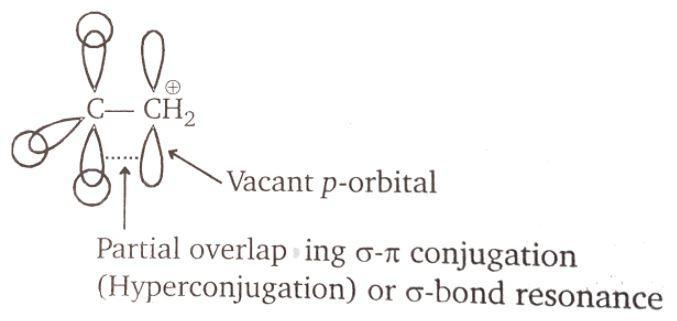
How many carbon-hydrogen bond orbitals are available for overlap with the vacant p-orbital in ethyl carbocation?
(a) 0
(b) 3
(c) 5
(d) 6
Answer
158.1k+ views
Hint: Carbocation is a species in which the carbon atom has a positive charge and can form three bonds. Stability of carbocation depends on the number of carbon atoms and functional groups attached to it.
Complete step by step solution:
-Ethyl carbocation is ethane in which one of the hydrogen is missing from one carbon and it has a positive charge on that carbon atom. The structure of ethyl carbocation is as shown in the figure below

-Now let us see how many p orbitals are there vacant in the carbocation.

There are two vacant orbitals. The carbon next to carbocation has carbon-hydrogen bonds. All the three are available for the overlap with the vacant orbital of the carbocation. The vacant p-orbital forms a partial overlap giving a partial sigma-pi conjugation. This can also lead to hyperconjugation. Hyper conjugation is the interaction of the electrons in a sigma bond (C-H or C-C) with adjacent empty or partially filled p orbital or pi orbital and it gives an extended molecular orbital which increases the stability of the system. It is not resonance.
Hence, the 3 carbon-hydrogen bonds are available for overlap with the vacant p-orbital of the ethyl carbocation. The correct answer to the question is option (b).
Note: Due to the vacant p orbital, carbocation is electron deficient. Because of this, it can act as an electrophile. Carbocation has a trigonal planar shape.
Complete step by step solution:
-Ethyl carbocation is ethane in which one of the hydrogen is missing from one carbon and it has a positive charge on that carbon atom. The structure of ethyl carbocation is as shown in the figure below

-Now let us see how many p orbitals are there vacant in the carbocation.

There are two vacant orbitals. The carbon next to carbocation has carbon-hydrogen bonds. All the three are available for the overlap with the vacant orbital of the carbocation. The vacant p-orbital forms a partial overlap giving a partial sigma-pi conjugation. This can also lead to hyperconjugation. Hyper conjugation is the interaction of the electrons in a sigma bond (C-H or C-C) with adjacent empty or partially filled p orbital or pi orbital and it gives an extended molecular orbital which increases the stability of the system. It is not resonance.
Hence, the 3 carbon-hydrogen bonds are available for overlap with the vacant p-orbital of the ethyl carbocation. The correct answer to the question is option (b).
Note: Due to the vacant p orbital, carbocation is electron deficient. Because of this, it can act as an electrophile. Carbocation has a trigonal planar shape.
Recently Updated Pages
JEE Atomic Structure and Chemical Bonding important Concepts and Tips

JEE Amino Acids and Peptides Important Concepts and Tips for Exam Preparation

JEE Electricity and Magnetism Important Concepts and Tips for Exam Preparation

Chemical Properties of Hydrogen - Important Concepts for JEE Exam Preparation

JEE Energetics Important Concepts and Tips for Exam Preparation

JEE Isolation, Preparation and Properties of Non-metals Important Concepts and Tips for Exam Preparation

Trending doubts
JEE Main 2025 Session 2: Application Form (Out), Exam Dates (Released), Eligibility, & More

JEE Main 2025: Derivation of Equation of Trajectory in Physics

Electric Field Due to Uniformly Charged Ring for JEE Main 2025 - Formula and Derivation

Displacement-Time Graph and Velocity-Time Graph for JEE

Geostationary Satellites and Geosynchronous Satellites - JEE Important Topic

Degree of Dissociation and Its Formula With Solved Example for JEE

Other Pages
JEE Advanced Marks vs Ranks 2025: Understanding Category-wise Qualifying Marks and Previous Year Cut-offs

JEE Advanced Weightage 2025 Chapter-Wise for Physics, Maths and Chemistry

NCERT Solutions for Class 11 Chemistry In Hindi Chapter 1 Some Basic Concepts of Chemistry

JEE Advanced 2025 Notes

JEE Main 2025: Conversion of Galvanometer Into Ammeter And Voltmeter in Physics

Learn About Angle Of Deviation In Prism: JEE Main Physics 2025




